
|
GREAT WESTERN
STATIONS MENU
|
|
|
|
A Selection of Great Western Stations
|
|
Abingdon
Origin: Abingdon Railway Company
Opened: 2nd June 1856
Closed: Passengers - 9th September 1963
|
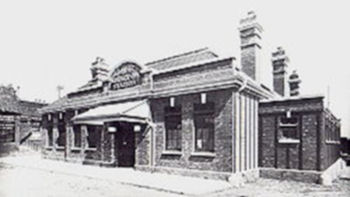 |
The branch line to Abingdon station originated from a junction with the main line from Oxford to Didcot close to Nuneham Courtenay. At this junction, a halt was built for the exchange of passengers for the broad-gauge single branch line and this halt remained in use until a new station was built at Radley, one mile north of the junction. Worked by the Great Western from the outset, the line had a rising gradient of 1 in 200 with a maximum speed restriction of 40 miles per hour except at the main line junction, which had a 10 miles per hour restriction.
The original Abingdon station built by the Abingdon Railway was a very dismal place, and despite the many letters of complaint, nothing was done. Occasionally, trains would overrun the buffer stops causing a little damage, but on the 22nd April 1908, a goods train overran with such force to demolish a large area of the station building. The Great Western, having taken over the line in 1904, lost little time in erecting a fine building designed by W. W. Grierson.
|
| |
Adlestrop
Origin: Oxford, Worcester & Wolverhampton Railway
Opened: 4th June 1853
Previous Name: Addlestrop & Stow Road until 1st March 1862, Addlestrop until 1st July 1883
Closed: Passengers - 3rd January 1966
Goods - 26th August 1963
|
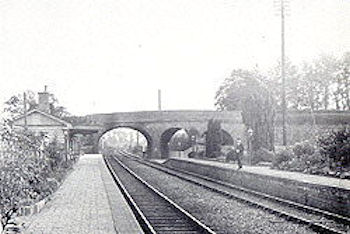 |
Situated on the 40-mile section of 'Cotswold Line' from Wolvercot Junction near Oxford to Evesham, Adlestrop was everybody's idea of a typical country GWR station. Built with a mixed gauge single track that was doubled on 2nd August 1858, the one oddity within the station was the addition of a broad gauge passing loop. However, the only broad gauge train to use the loop was the inspection train two days before opening day.
Very little change occurred to Adlestrop station over the years. The siding was lengthened in 1881 from stopping short of the right-hand platform in the picture above to behind it, and the station building lost its canopies in the 1930's.
|
Aldermaston
Origin: Great Western Railway
Opened: 21st December 1847
Renamed: Aldermaston Halt on 5th May 1969
Closed: Goods - 6th December 1965
|
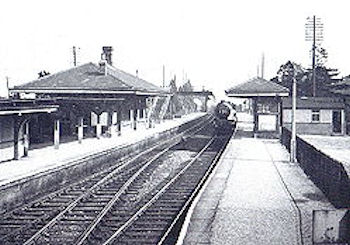 |
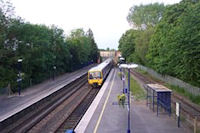 The station buildings were typical for the period and location and similar styles were adopted for Pangbourne, Thatcham, Midgham and Theale. Built in the 'chalet' style with roofs extending over the buildings' outline to form an awning right to the edge of the platform, the buildings were both functional and pleasing to the eye. The station buildings were typical for the period and location and similar styles were adopted for Pangbourne, Thatcham, Midgham and Theale. Built in the 'chalet' style with roofs extending over the buildings' outline to form an awning right to the edge of the platform, the buildings were both functional and pleasing to the eye.
Alterations to the station included a new signal box in 1920, and later, as commuter services increased, platform extensions with a new, if rather heavy looking, platform awning shown on the extreme left of the picture. With the reduction of goods traffic, the goods shed, shed road and the down trailing crossover were removed in late 1967.
|
| |
Badminton
Origin: Great Western Railway
Opened: Goods - 1st January 1903
Passengers - 1st July 1903
Closed: Goods - 1st November 1966
Passengers - 3rd June 1968
|
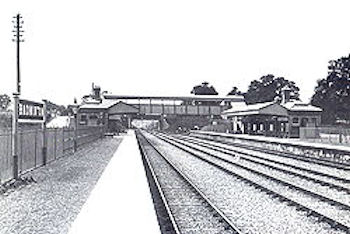 |
Situated on the South Wales direct line north of Bristol, Badminton station contained the typical GWR single story buildings on both sides and with the platforms connected by a typical GWR footbridge. Although the track layout was of the four through road design, stopping passenger services were meagre and the platform lines were mostly used as refuges for goods trains so as not to hamper the progress of express trains.
Despite the fact that the station was 100 miles from Paddington, the heavy through traffic of both goods and passenger nature meant that the signal box was continually open. Notwithstanding the busy scene, the station was set amid the magnificent Cotswold farmland of the Duke of Beaufort, and his coat of arms was mounted on a plaque in the wall of the 'upside' building.
|
| |
Banbury
Origin: Great Western Railway
Opened: 2nd September 1850
|
 |
Although the Great Western had initially promoted the idea of an Oxford & Rugby Railway, by 1849 the GWR decided that gauge interchange problems at Rugby would cause many difficulties. As a result, the line from the junction of the Birmingham & Oxford Junction Railway at Fenny Compton to Rugby was abandoned, however the line from Fenny Compton southwards to Oxford experienced problems with finance and the need to replace the original contractor. Consequently, it was not until the 2nd September 1850 that the 24 mile single track broad-gauge section opened from Oxford to Banbury. This was improved to a double track mixed-gauge replacement track on 1st October 1852, about the same time that the section of line from Banbury to Birmingham. The Great Western was not the first railway to reach Banbury though, as the Buckinghamshire Railway, part of the L.&N.W.R. empire, opened its terminal station at Merton Street on 1st May 1850.
The first station at Banbury had an overall timber roof (that was described as 'Brunel's design for less important stations', but rather than Brunel, it is far more likely that Bertram or Hannaford drew the plans) and after the 1852 line doubling, the station was served by 'up' and 'down' lines only, but in 1884 various extensions and improvements were made including the addition of another 'up' line. Major changes took place at Banbury in 1903 when the additional 'up' line was altered to 'up' and 'down' bay lines together with another bay added on the 'downside'. Loops were also installed at the station for the extra freight traffic arising from the opening of the Great Central Railways branch from Banbury Junction, 1¼ miles north of the station. Also in late 1903, requirements for a refreshment room to replace the cake stand were needed together with additional parcels
accommodation, and on 6 October 1908, a new larger engine shed opened. at Banbury had an overall timber roof (that was described as 'Brunel's design for less important stations', but rather than Brunel, it is far more likely that Bertram or Hannaford drew the plans) and after the 1852 line doubling, the station was served by 'up' and 'down' lines only, but in 1884 various extensions and improvements were made including the addition of another 'up' line. Major changes took place at Banbury in 1903 when the additional 'up' line was altered to 'up' and 'down' bay lines together with another bay added on the 'downside'. Loops were also installed at the station for the extra freight traffic arising from the opening of the Great Central Railways branch from Banbury Junction, 1¼ miles north of the station. Also in late 1903, requirements for a refreshment room to replace the cake stand were needed together with additional parcels
accommodation, and on 6 October 1908, a new larger engine shed opened.
As part of the 1935 Government Guarantee Loan scheme the then huge amount of £167,250 was allocated to the rebuilding of Banbury station together with a new goods shed, a warehouse and offices. Approved in February 1937, the next two years saw a major programme of re-armament within the forces, and with the likelihood of war, Banbury had to wait until 1958 for its new station. Small improvements were made during the Second World War including upgrading work to the locomotive depot, additional booking office and parcels accommodation and a female staff mess room. At the beginning of 1945, the Great Western bought 19¼ acres of land from the local Co-operative Society with a view to expanding the facilities at Banbury at a later date. programme of re-armament within the forces, and with the likelihood of war, Banbury had to wait until 1958 for its new station. Small improvements were made during the Second World War including upgrading work to the locomotive depot, additional booking office and parcels accommodation and a female staff mess room. At the beginning of 1945, the Great Western bought 19¼ acres of land from the local Co-operative Society with a view to expanding the facilities at Banbury at a later date.
1953 saw the removal of the overall roof at Banbury, by which time every express train that passed close by threatened to shake it down. The roof became legendary for its latter day frailty which is a pity considering the 103 years of sterling service that it gave. Between 1956 and 1958, the promised rebuilding of Banbury station took place together with lengthened platforms, central heating and fluorescent lighting and lots of glass.
Reduction of the facilities at Banbury started on the 2nd January 1961 when Merton Street and the Buckinghamshire line closed to passengers, with the closure of freight traffic effective from 2nd December 1963. Merton Street survived at a freight depot until 6th June 1966. Due to the abolition of steam, Banbury locomotive shed shut on 3rd October 1966. Over the next few years, various sidings, loops and consequently signal boxes were made redundant, including the main signal box at Banbury Junction on 24th March 1980.
|
| |
Barnstaple (Victoria Road)
Origin: Devon & Somerset Railway
Opened: 1st November 1873
Previous Name: Barnstaple until 26th September
1949
Closed: Passengers - 13th June 1960
Goods - 5th March 1970
|
 |
Built to broad gauge standard throughout its length, the Devon and Somerset Railway's line from Norton Fitzwarren opened to Barnstaple on the 1st of November 1873. Conversion from broad gauge to standard gauge of the 43 mile was completed between 14th and 18th May 1881. A spur was built from the station on 1st June 1887 to the L.S.W.R. Junction station enabling a connection to Ilfracombe, although this spur was modified in July 1905 into a loop avoiding the Great Western station.
Trains from Taunton to Ilfracombe that carried passengers for Barnstaple did not pull into Barnstaple station but came to a stand close to the Barnstaple South Junction pointwork. A pilot engine would then detach the Barnstaple portion of the train and pull it into the station. Trains from Ilfracombe to Taunton were brought to a halt near to the Barnstaple East Junction before detachment of the Barnstaple portion.
Upon closure of the station to passengers, trains for Barnstaple were diverted to the L.S.W.R. station.
|
| |
Basingstoke
Origin: Great Western Railway
Opened: 1st November 1848
Closed: 1st January 1932
|
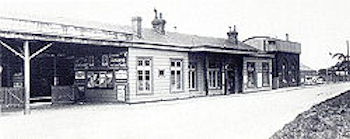 |
The Great Western applied to Parliament for railways between Reading to Newbury and Reading to Basingstoke, known as the Berks and Hants Line, and although the plans were sanctioned in 1845, the southern fork to Basingstoke was not completed until 1848. The reason for the delay was due to aggression shown by the London and South Western Railway for the Great Western to build Basingstoke alongside the existing L. & S.W.R. station.
Two broad gauge lines were planned, but at the time, doubts were expressed about the use of the Great Western gauge so much that in 1846 prior to the station being built, the Gauge Commissioners together with the Regulation of Gauge Act recommended to Parliament that the line from Oxford to Reading and Basingstoke should be built using the 'narrow' 4 feet 7½ inch gauge. This the GWR directors agreed to, but for six long years after the station was opened, nothing was done. Eventually in 1854, the Great Western was ordered to convert the railway to the 'narrow' gauge between Reading and Basingstoke by the 7th of February 1856, or face a fine of £200 each day. Whether any penalties were paid is not known, but mixed gauge line were not laid down until 22nd December 1856.
Basingstoke kept its separate Great Western station until 1st January 1932 when trains were diverted into the L. & S.W.R. station with addition of one platform, still in use today, from the old station.
|
| |
Bath Spa
Origin: Great Western Railway
Opened: 31st August 1840
|
 |
It was intended that the line from Bristol to Bath would open in the Spring of 1838, but problems with the contractor, who was eventually dismissed, the very wet winter of 1839 and problems with the bridge east of the station, delayed the opening until the 31st August 1840, making this line the sixth part of the Paddington to Bristol route to open. Even then, Bath station was not fully completed and further building continued until the opening of the Bath to Chippenham line, which marked the completion of the route, on 30th June 1841.
A quick look at the site of Bath station would give the impression that Brunel could not have made things any more difficult if he had tried. The station approaches from the east and west used viaducts as did the station itself. Surrounded by the River Avon in a semi-circular fashion, the site was very cramped. Space for sidings was very restricted and those at the west end of the station were enclosed in a goods shed. The difficulties experienced with building the bridge west of the station were simple; no contractor would take the job on and so  Brunel had to 'run' a timber bridge up himself. To quote J. C. Bourne's description from his "History of the Great Western Railway" of 1846, he writes 'The angle at which the bridge crosses the river is so considerable that, although the space from quay to quay is only 80 feet, the space traversed by the railway is 164 feet. The bridge is in two arches, each of 80 feet span. Each arch is composed of six ribs placed about five feet apart and springing from the abutment and a central pier of masonry. Each rib is constructed of five horizontal layers of Memel timber held together with bolts and iron straps. The end or butt of each rib is enclosed in a shoe or socket of cast iron, resting with the intervention of a plate upon the springing stones, the shoes on the middle pier are common to the two ribs.' This bridge was replaced in 1878 which, in its turn, has been superseded by the present construction. The bridge on the east side of the station was much easier to build and this had an 88 feet span that run onto a viaduct of 37 arches to the handsome London Road bridge. Brunel had to 'run' a timber bridge up himself. To quote J. C. Bourne's description from his "History of the Great Western Railway" of 1846, he writes 'The angle at which the bridge crosses the river is so considerable that, although the space from quay to quay is only 80 feet, the space traversed by the railway is 164 feet. The bridge is in two arches, each of 80 feet span. Each arch is composed of six ribs placed about five feet apart and springing from the abutment and a central pier of masonry. Each rib is constructed of five horizontal layers of Memel timber held together with bolts and iron straps. The end or butt of each rib is enclosed in a shoe or socket of cast iron, resting with the intervention of a plate upon the springing stones, the shoes on the middle pier are common to the two ribs.' This bridge was replaced in 1878 which, in its turn, has been superseded by the present construction. The bridge on the east side of the station was much easier to build and this had an 88 feet span that run onto a viaduct of 37 arches to the handsome London Road bridge.
Referring to the station prior to rebuilding in 1897, four broad-gauge tracks were installed of which two were 'outer' platform lines and two 'inner' sidings. An overall roof gave some coverage to half the length of the platforms. A connecting footbridge was built to the Royal Hotel opposite the station.
1877 saw the opening of the Westmoreland Goods station, half a mile to the west of Bath station. This made the goods shed at Bath redundant, but conversely gave additional space at the station site. Additionally, a small engine shed was moved from Bath station to Westmoreland in 1880. As mentioned earlier, the station was rebuilt in 1897. Removal 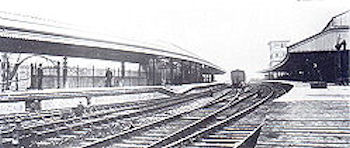 of the overall roof and extensions to the buildings and platform lengths gave some improvement but due to the available space, very little was altered in track layout. A new signal box was built in the station roof replacing the two boxes near to the east and west bridges. of the overall roof and extensions to the buildings and platform lengths gave some improvement but due to the available space, very little was altered in track layout. A new signal box was built in the station roof replacing the two boxes near to the east and west bridges.
Over the next few years, many small improvements were made to Bath station including the provision of track circuiting in 1914 and 1915, rebuilding of one of the subways beneath the station in 1930, and removal of the now unnecessary footbridge to the Royal Hotel in 1936. During the Second World War, Bath station became target practice for the German air-force and in April 1942 substantial damage was caused to the canopy and buildings on the south-side of the station together with major damage to the Westmoreland Goods Depot. The station canopy was not repaired until after the war.
By 1960, the track layout at Bath, by now renamed Bath Spa, was looking a little antique in appearance, and in response, the 'up' platform at the west end was lengthened together with the removal of the siding that ran up to the old goods shed, and the 'down' platform was lengthened at the east end with the abandonment of the short turntable and its three stubs. Bath engine shed at Westmoreland closed in February 1961. Further modifications were made in November 1962 when the 'down' middle siding was removed and the 'up' middle siding was made into a dead-end, however this siding was taken out of use in 1967 together with the 'up' bay line and the east-end crossover.
Bath Spa signal box closed on the 21st January 1968 and the station closed to goods traffic on 31st December 1980. Nowadays, the station is well served by High Speed Trains.
Copyright © by John Daniel 2013.
|
| |
|










 The station buildings were typical for the period and location and similar styles were adopted for Pangbourne, Thatcham, Midgham and Theale. Built in the 'chalet' style with roofs extending over the buildings' outline to form an awning right to the edge of the platform, the buildings were both functional and pleasing to the eye.
The station buildings were typical for the period and location and similar styles were adopted for Pangbourne, Thatcham, Midgham and Theale. Built in the 'chalet' style with roofs extending over the buildings' outline to form an awning right to the edge of the platform, the buildings were both functional and pleasing to the eye. at Banbury had an overall timber roof (that was described as 'Brunel's design for less important stations', but rather than Brunel, it is far more likely that Bertram or Hannaford drew the plans) and after the 1852 line doubling, the station was served by 'up' and 'down' lines only, but in 1884 various extensions and improvements were made including the addition of another 'up' line. Major changes took place at Banbury in 1903 when the additional 'up' line was altered to 'up' and 'down' bay lines together with another bay added on the 'downside'. Loops were also installed at the station for the extra freight traffic arising from the opening of the Great Central Railways branch from Banbury Junction, 1¼ miles north of the station. Also in late 1903, requirements for a refreshment room to replace the cake stand were needed together with additional parcels
accommodation, and on 6 October 1908, a new larger engine shed opened.
at Banbury had an overall timber roof (that was described as 'Brunel's design for less important stations', but rather than Brunel, it is far more likely that Bertram or Hannaford drew the plans) and after the 1852 line doubling, the station was served by 'up' and 'down' lines only, but in 1884 various extensions and improvements were made including the addition of another 'up' line. Major changes took place at Banbury in 1903 when the additional 'up' line was altered to 'up' and 'down' bay lines together with another bay added on the 'downside'. Loops were also installed at the station for the extra freight traffic arising from the opening of the Great Central Railways branch from Banbury Junction, 1¼ miles north of the station. Also in late 1903, requirements for a refreshment room to replace the cake stand were needed together with additional parcels
accommodation, and on 6 October 1908, a new larger engine shed opened. programme of re-armament within the forces, and with the likelihood of war, Banbury had to wait until 1958 for its new station. Small improvements were made during the Second World War including upgrading work to the locomotive depot, additional booking office and parcels accommodation and a female staff mess room. At the beginning of 1945, the Great Western bought 19¼ acres of land from the local Co-operative Society with a view to expanding the facilities at Banbury at a later date.
programme of re-armament within the forces, and with the likelihood of war, Banbury had to wait until 1958 for its new station. Small improvements were made during the Second World War including upgrading work to the locomotive depot, additional booking office and parcels accommodation and a female staff mess room. At the beginning of 1945, the Great Western bought 19¼ acres of land from the local Co-operative Society with a view to expanding the facilities at Banbury at a later date. Brunel had to 'run' a timber bridge up himself. To quote J. C. Bourne's description from his "History of the Great Western Railway" of 1846, he writes 'The angle at which the bridge crosses the river is so considerable that, although the space from quay to quay is only 80 feet, the space traversed by the railway is 164 feet. The bridge is in two arches, each of 80 feet span. Each arch is composed of six ribs placed about five feet apart and springing from the abutment and a central pier of masonry. Each rib is constructed of five horizontal layers of Memel timber held together with bolts and iron straps. The end or butt of each rib is enclosed in a shoe or socket of cast iron, resting with the intervention of a plate upon the springing stones, the shoes on the middle pier are common to the two ribs.' This bridge was replaced in 1878 which, in its turn, has been superseded by the present construction. The bridge on the east side of the station was much easier to build and this had an 88 feet span that run onto a viaduct of 37 arches to the handsome London Road bridge.
Brunel had to 'run' a timber bridge up himself. To quote J. C. Bourne's description from his "History of the Great Western Railway" of 1846, he writes 'The angle at which the bridge crosses the river is so considerable that, although the space from quay to quay is only 80 feet, the space traversed by the railway is 164 feet. The bridge is in two arches, each of 80 feet span. Each arch is composed of six ribs placed about five feet apart and springing from the abutment and a central pier of masonry. Each rib is constructed of five horizontal layers of Memel timber held together with bolts and iron straps. The end or butt of each rib is enclosed in a shoe or socket of cast iron, resting with the intervention of a plate upon the springing stones, the shoes on the middle pier are common to the two ribs.' This bridge was replaced in 1878 which, in its turn, has been superseded by the present construction. The bridge on the east side of the station was much easier to build and this had an 88 feet span that run onto a viaduct of 37 arches to the handsome London Road bridge. of the overall roof and extensions to the buildings and platform lengths gave some improvement but due to the available space, very little was altered in track layout. A new signal box was built in the station roof replacing the two boxes near to the east and west bridges.
of the overall roof and extensions to the buildings and platform lengths gave some improvement but due to the available space, very little was altered in track layout. A new signal box was built in the station roof replacing the two boxes near to the east and west bridges.